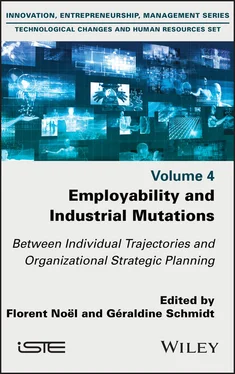Choosing the theme of employability is far from trivial. As our partners suggest in the joint foreword they have written together, referring to employability in France is a political choice. When the word was dropped into the public debate in the mid-1990s by Jacques Barrot, then French Minister of Labor, it announced a change of perspective: the fight against the mass unemployment that was plaguing French society did not necessarily involve preventing redundancies, but could also involve better equipping workers for their professional transition. This is a paradigm shift for HRM thinking: adjusting employment is no longer a shameful decision as soon as employees find internal or external re-employment. Betting on employability means betting on movement and adaptability and giving up on stability and immobility; it means thinking of the “work factor” as a flow and no longer as a resource.
Since then, a succession of reforms has been introduced to support this project: greater flexibility in the terms and conditions for terminating employment contracts (with redundancy gradually giving way to contractual termination), the development of access to training independently of the employer, the portability of social rights, and the development of a rhetoric that makes individuals responsible for their own career paths. If yesterday’s “talent” made it possible to find a “good situation”, today’s “talent” consists of knowing how to be wary of putting down roots and moving from situation to situation by seizing opportunities.
This change of perspective is part of fundamental societal changes – the “liquid society”. It also reflects and makes possible a change in changes. These changes are probably more rapid, and quantitative and qualitative adjustments to the workforce can no longer be matched at the rate of generational renewal. The feeling has taken hold that there is an urgent need to adapt always and everywhere to new technologies, to intensifying competition, and to an environment that has become so turbulent that any effort at planning has become futile. Employability is seen as an imperative: an imperative for job seekers, obviously; an imperative for employees for whom being employable allows them to remain in employment despite the changes; an imperative for companies, which can see it as a way of succeeding in their transformations, all the more so because mobility is less costly for employees.
However, this rosy picture needs to be qualified. Although, at first glance, employability is defined as the ability to find a job or remain in a job, it is only a solution if workers have the concrete possibility of seizing quality opportunities and of not embarking on career paths marked by precariousness, downgrading and loss of income. However, the changes we are talking about here often have the effect of destroying the value of acquired skills and putting workers in competition with each other each time they appear on the internal or external labor markets. Flexibility without insecurity is the challenge.
This collective work returns to these questions. First, the concept of employability and its implications for public authorities, organizations and employees will be better defined (Part 1). It will then be possible to specify several figures of the employable or unemployable worker to better understand what being employable means (Part 2). Then, examples of management systems will be presented, all of which contribute to the development of employability at different stages of a career: recruitment, skills upgrading and reclassification (Part 3). Finally, the question of developing or maintaining employability will be examined as the result of the work situations and contexts in which workers evolve (Part 4).
The first part of this book aims to clarify the issues involved in thinking about employability by crossing disciplinary perspectives. In Chapter 1, Bernard Gazier first traces the history of the concept by adopting the point of view of the public authorities, for whom the challenge is to deal with the nagging issue of mass unemployment and to fight against the casualization and downgrading of workers. This leads him to look back at the various employment policies that have followed one another and that have become sedimented. Between measures to evict people from the labor market, the fight against discrimination, access to training and career guidance services, different conceptions of employability are emerging, ranging from the objectives of combating poverty to the “construction” of a worker responsible for his or her career and able to interact with the opportunities offered by the labor market and institutions. Géraldine Schmidt and Florent Noël ( Chapter 2) approach the issue of employability from a business perspective: developing employability is one of the conditions for the success of the restructuring, mutations and transformations that companies must carry out to remain competitive. Making employees employable ultimately means facilitating professional transitions and making changes more easily acceptable. This means planning workforce movements and skills development efforts, and also empowering employees. It can also mean letting employees decide on the direction of their activity and thus build, in an emergent and bottom-up way, the organization and even the strategy of the company. This brings us to the emancipatory conception of employability put forward by Bénédicte Zimmermann in Chapter 3, who, on the basis of fieldwork, explores the conditions under which employability is confused with the ability of individuals to widen their field of possibilities to enable them to make professional choices of value to them, thus distancing themselves from the constraints of the labor market, on the one hand, and organizational rigidities, on the other hand. These three contributions set out the terms of the debate: the challenge of employability is not only to gain access to employment or to remain in employment, but also to aim for dignified living conditions and ultimately to aspire to freedom.
This broadening of perspectives allows us in the second part to draw a portrait of employable or, in a sense, unemployable workers. It is a question of discussing “what staying on the sidelines” or “being in the running” could be. To this end, Chapter 4, written by Raymonde Ferrandi on the basis of her experience as a psychologist working in social services to help with social and professional integration, draws up a series of portraits of people excluded from employment. These are people who are not allowed to work for administrative or medical reasons, or people who belong to discriminated groups. They are sometimes people who do not manage to master the social codes in force in the world of work or who, for various reasons, keep themselves away from work, which they see as an insurmountable situation. It is the weight of social representations of people or individual representations of work that is highlighted. In contrast to these problems of exclusion, Pauline de Becdelièvre, Cindy Felio and Jean-Yves Ottmann focus in Chapter 5on qualified Information Technology workers who embark on the adventure of self-employment. The life stories they present are those of workers wishing to emancipate themselves from subordination – sometimes driven by a desire for independence, sometimes as a result of accidents along the way – who then have to work on themselves and for themselves to make themselves attractive. Constant monitoring of new technologies and professional practices, “self-marketing“ and the maintenance of networks become the conditions, not always met, for their professional development. Martina Gianecchini, Paolo Gubitta and Sara Dotto finally address the problem of employability for “stable” employees ( Chapter 6). Their questionnaire survey of a large sample of Italian workers shows the importance of the ability to interact broadly with the various trades that make up a company. Particularly for jobs related to innovation or team management, mastering a particular expertise is not enough. The “digital revolution”, in particular, requires an interest in other specialties. This observation leads the authors to plead for the return of the “honest man of the Renaissance”, gifted with a broad and general understanding of problems and capable of imposing himself in project mode.
Читать дальше












